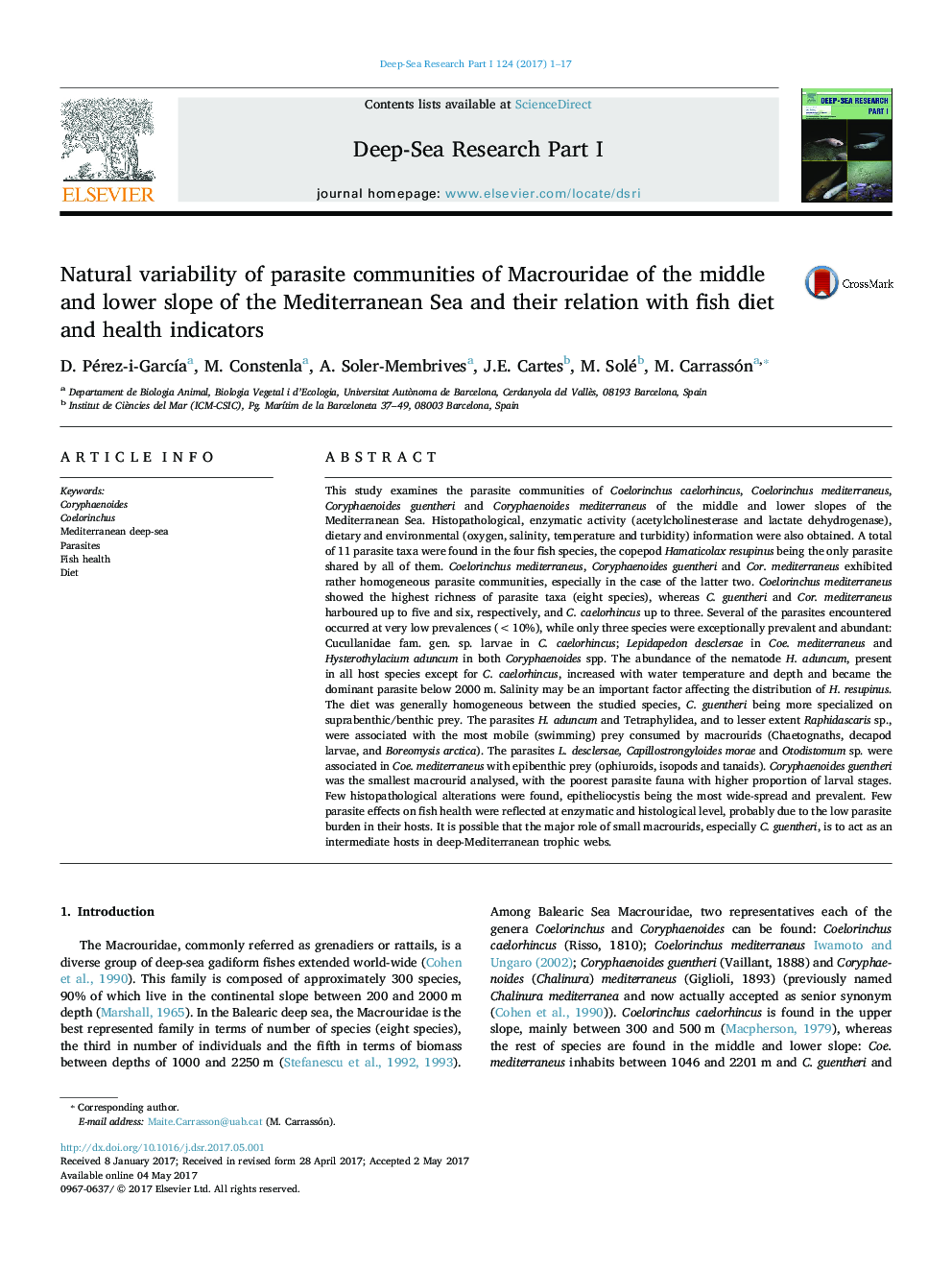| کد مقاله | کد نشریه | سال انتشار | مقاله انگلیسی | نسخه تمام متن |
|---|---|---|---|---|
| 5764692 | 1626306 | 2017 | 17 صفحه PDF | دانلود رایگان |

- Poor parasite richness and diversity in Mediterranean macrourids below 1000Â m depth.
- Macrourids act mainly as intermediate hosts for parasites in different larval stages.
- Highly diverse diet is not translated to high parasite diversity.
- Parasite infections showed no pathological effect at enzymatic and histological level.
- Epitheliocystis is widely spread among deep Mediterranean macrourids.
This study examines the parasite communities of Coelorinchus caelorhincus, Coelorinchus mediterraneus, Coryphaenoides guentheri and Coryphaenoides mediterraneus of the middle and lower slopes of the Mediterranean Sea. Histopathological, enzymatic activity (acetylcholinesterase and lactate dehydrogenase), dietary and environmental (oxygen, salinity, temperature and turbidity) information were also obtained. A total of 11 parasite taxa were found in the four fish species, the copepod Hamaticolax resupinus being the only parasite shared by all of them. Coelorinchus mediterraneus, Coryphaenoides guentheri and Cor. mediterraneus exhibited rather homogeneous parasite communities, especially in the case of the latter two. Coelorinchus mediterraneus showed the highest richness of parasite taxa (eight species), whereas C. guentheri and Cor. mediterraneus harboured up to five and six, respectively, and C. caelorhincus up to three. Several of the parasites encountered occurred at very low prevalences (<10%), while only three species were exceptionally prevalent and abundant: Cucullanidae fam. gen. sp. larvae in C. caelorhincus; Lepidapedon desclersae in Coe. mediterraneus and Hysterothylacium aduncum in both Coryphaenoides spp. The abundance of the nematode H. aduncum, present in all host species except for C. caelorhincus, increased with water temperature and depth and became the dominant parasite below 2000Â m. Salinity may be an important factor affecting the distribution of H. resupinus. The diet was generally homogeneous between the studied species, C. guentheri being more specialized on suprabenthic/benthic prey. The parasites H. aduncum and Tetraphylidea, and to lesser extent Raphidascaris sp., were associated with the most mobile (swimming) prey consumed by macrourids (Chaetognaths, decapod larvae, and Boreomysis arctica). The parasites L. desclersae, Capillostrongyloides morae and Otodistomum sp. were associated in Coe. mediterraneus with epibenthic prey (ophiuroids, isopods and tanaids). Coryphaenoides guentheri was the smallest macrourid analysed, with the poorest parasite fauna with higher proportion of larval stages. Few histopathological alterations were found, epitheliocystis being the most wide-spread and prevalent. Few parasite effects on fish health were reflected at enzymatic and histological level, probably due to the low parasite burden in their hosts. It is possible that the major role of small macrourids, especially C. guentheri, is to act as an intermediate hosts in deep-Mediterranean trophic webs.
Journal: Deep Sea Research Part I: Oceanographic Research Papers - Volume 124, June 2017, Pages 1-17